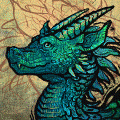#1 2012-04-12 07:09:52 | 显示全部楼层
- Enedina
- 角龍

- Registered: 2011-11-11
- Posts: 599
回应: 關於飛行的危險性
龍要執照才能飛就真的第一次聽,但說到龍有禁飛區或飛行高度限制就聽過不少次。
如何說呢,作者比喻龍的身體為車輛,其駕駛者(宿主)要學車就必須要有指導員(另一個占據宿主身體的靈魂??)陪同和訓導才能駕駛。這樣說行不通啊,難道指導員能把車輛停下,就表示學飛的龍也會被某靈魂強行把牠飛下來嗎?
這點就真的值得大家共同討論。
說到鳥類學飛的死亡率,極少數是摔死的,但很多都是因為缺乏求生經驗,而被猛禽追蹤,不是逃亡的時候把自己撞死,又或者失去力氣而墜地,就是在半空中被捕殺了。至於後者,只知道在飛行速度在每小時20公里的情況下撞向玻璃就等同人類奔跑時把頭顱撞向牆壁,不是被撞的血肉模糊就是全身癱瘓而死。
离线
#2 2012-04-12 11:10:49 | 显示全部楼层
- Enedina
- 角龍

- Registered: 2011-11-11
- Posts: 599
回应: 關於飛行的危險性
學飛…學飛…呃,不就是要找到最合乎氣動佈局的飛行姿態才行嗎? 這樣說的話,把幼龍帶到大型風洞室去練習不就成了? 一來是室內,不會影響公眾,二來即使發生意外,也不會傷及無辜,以及可以立即急救。
最后修改: Enedina (2012-04-12 11:13:03)
离线
#3 2012-04-18 01:04:42 | 显示全部楼层
- Enedina
- 角龍

- Registered: 2011-11-11
- Posts: 599
回应: 關於飛行的危險性
降落對龍的飛行來說應該是更大的難題...如果說助跑+蹬地可以是起飛的助力
那麼在降落的時候,需要的地方一定也不會小。光是靠爪子來做的話,磨損和本身承受重力會不成正比。
龍着陸時通常是先向上攀升後再垂直落下的,應該可以用有一定高度的架子去着陸嗎? 如果不行,也許拿些灌木或欄阻網去迫降也可以。
最后修改: Enedina (2012-04-18 01:05:41)
离线
#4 2012-04-18 21:24:25 | 显示全部楼层
- Enedina
- 角龍

- Registered: 2011-11-11
- Posts: 599
回应: 關於飛行的危險性
記得龍是利用身體裡的氣囊(裝氫氣)來飛行的吧'
畢竟龐大的身軀照常理來講不太可能只靠兩隻翅膀支撐全身的重量
(人家鳥類為了飛都把骨骼變輕什麼的 一條巨龍只靠兩隻翅膀就可以飛了@@)所以就跟魚類為了能輕鬆上下移動(跟淺水艇一樣的道理)
龍族只要把體內的氫氣排光不就得了??
意思是...噴火把氫氣噴光XDD
不少書本也有相類似的解釋 (包括著名的"Dragonology"),連喜歡研究龍的Kate也支持這一點,是不是該重新反思一下低壓氣囊等器官在飛龍身體內的可能性呢?
------

Some of this may be quoting John Conway's pterosaur research: The Pulmonary SASS (Subcutaneous air sac system) are a complex system of air sacs located beneath the skin that act as bellows for the lungs as well as to pneumatisize bones -filling them with air, meaning the bones can be bigger without being heavier or weaker. To be specific, they have post-cranial skeletal and soft-tissue pneumaticity; meaning there are hexagonal (honeycomb structured) spaces and pneumatic foramina filled with air within the bone and some tissue. The pneumatisation in the wings perhaps being fueled by the SASS. The air sacs may have have played a structural role in holding wing shape and posture, as they do in some birds. This feature aids in the oxygenation of the muscles, and unidirectional flow of oxygen in the lungs. Their large lungs, coupled with their efficiency of exacting oxygen from the air serve to support their size and powerful flight muscles. The SASS would also allow the animal to control the mechanical properties of the wing, perhaps even allowing the inflation to be used in display as it does in some birds.
Also from pterosaurs- the top layer of the wing is the actinofibrils, which help give shape and support to the wing.
最后修改: Enedina (2012-04-18 21:26:30)
离线
 爪機版
爪機版 龙,鳞虫之长。广义的龙族涵盖所有类龙生物,所以网站叫做 鳞目界域——“有鳞目”的领域
龙,鳞虫之长。广义的龙族涵盖所有类龙生物,所以网站叫做 鳞目界域——“有鳞目”的领域